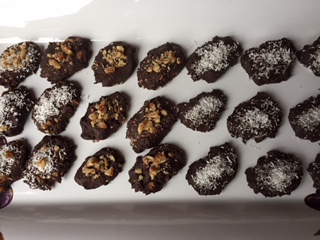 Every Valentine’s Day we woo our partners with flowers, champagne, good food, and above all, chocolate. And for good reason. What better way to say, “I love you” than with the food of the Gods?
Every Valentine’s Day we woo our partners with flowers, champagne, good food, and above all, chocolate. And for good reason. What better way to say, “I love you” than with the food of the Gods?
The number one reason to eat chocolate is because it’s fantastically delicious but the numerous health benefits of raw cacao may surprise you. We’ll talk about those benefits in a moment, but first let’s clarify what is meant by chocolate vs cacao. Chocolate is made from cacao beans which are the fruit of a tree indigenous to the American jungle. The flowers of cacao trees are best pollinated by midges then develop into a pod-fruit (almost gives me a love for midges). The fruits usually start off green then ripen into red, orange, yellow, blue, or purple varieties after about five or six months. Each fruit usually grows to about seven or eight inches long and contains anywhere from 20-50 seeds or beans. These cacao beans are the raw form of chocolate.
It is likely that cacao made its way to Europe via the Spanish conquistador Cortez, who encountered the Aztecs and found that they, and the Mayans, highly revered cacao, so much so that they used it as currency instead of gold. Cortez brought cacao back to Spain and cacao spread from Spain into France, Holland, England, Belgium, Italy, and eventually throughout Western Europe. The first cultivation of cacao outside of the Americas was in Bioko, an island off the west coast of Africa with a climate perfect for growing cacao. Farmers planted cacao from Venezuela there in 1590 so that the cacao trade could be closer to Europe. It was the Europeans who began to combine refined cane sugar with cacao, whereas the Native Americans preferred the natural bitter taste of cacao.
In 1828 a Dutch chemist named Coenraad Johannes Van Houten patented a process for the manufacture of a new kind of low-fat powdered chocolate. In essence, he developed a hydraulic press that removed enough of the cacao butter/oil from the bean to make a “cake” that could be pulverized into a fine powder. In order to make this powder mix well with water, and more mild in flavor by default, Van Houten treated it with alkaline salts in a process now known as “Dutching”. This process allowed for large scale manufacturing and a more affordable product. In the mid 1800s a Swiss chemist, Henri Nestlé, found a way to powder milk by evaporation and after getting together with Swiss chocolate manufacturer Daniel Peter, introduced the first milk chocolate bar in 1879.
The raw cacao bean is one of nature’s most fantastic superfoods due to its high antioxidant value, mineral content (magnesium, iron, chromium, manganese, zinc, copper), and neurotransmitter rejuvenating properties. When sugar is added, the health benefits take a nose-dive as sugar is dehydrating, it draws minerals out of the body, it upsets and can cause blood sugar disorders, and it dilutes the cacao content thereby diluting the benefits that come with it. Does cacao contain caffeine? Yes, however, the amount of caffeine is less than that in one cup of conventional coffee. How about oxalic acid? Yes, but again, the oxalic acid content is somewhat lower than that found in spinach. If you need to avoid caffeine and/or oxalic acid (if you’re prone to kidney stones for example) I suggest you consult your healtcare provider to determine how much chocolate is safe for you to consume. Not only is pure chocolate safe for most people to consume in small amounts, but in its raw form, and even in some dark chocolate varieties, it packs an energetic, nutritional punch.
Now for the best part… My favorite chocolate is that which is as close to raw as possible. I love cacao nibs and chocolate that is 80-90% dark. Not only do I reap more of the health benefits, but I’m actually getting the true flavor of the cacao, rather than powdered milk or sugar. And dark chocolate just tastes so much better to me. In my book, The Optimal Health Cookbook: Your Guide to Real Food Made Easy, I have a recipe for dark chocolate delights. They are super easy to make and they will delight you and your sweetheart on Valentine’s Day!
Dark Chocolate Delights
Prep time: 20-25 minutes
Cook time: 0 minutes
Cool time: 30 minutes
Makes 20 pieces
Ingredients
1 cup dark chocolate pieces *
2 TBSP almond butter
1 TBSP maple syrup
1 tsp pure vanilla extract
2 TBSP finely chopped pecans, toasted (optional)
1 tsp cinnamon
1 tsp ground cardamom
2 TBSP unsweetened shredded coconut (toasted or raw) (optional)
* I use a different blend of chocolate each time I make this, whatever I have on hand,
but always dark (55% will do but 70%+ is best). My favorite blends usually include a
small amount of dark chocolate flavored with cinnamon or chili pepper. If you are dairy
free, choose your chocolate accordingly.
Preparation
1) Melt the chocolate pieces in a double boiler if you have one. I don’t own a double
boiler so I use a Pyrex® bowl over a pot with simmering water.
2) Stir in the almond butter, maple syrup, and vanilla extract.
3) Stir in the pecans, cinnamon, and cardamom.
4) Line a tray with wax or parchment paper. Drop chocolate mixture onto tray using
TBSP sized portions approximately 1⁄2 inch thick (don’t worry if the chocolate runs a
bit and is thinner). The chocolate should “dollop” off the spoon in an egg shape.
5) Sprinkle each piece with coconut and refrigerate for 30 minutes or until firm.
6) Serve or store in an airtight container in the refrigerator.
Enjoy!
References:
Superfoods by David Wolfe

